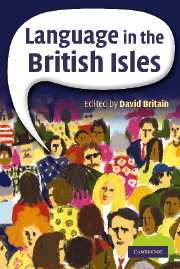Book contents
- Frontmatter
- Contents
- List of figures
- List of tables
- List of contributors
- Acknowledgements
- Map of the British Isles
- Introduction
- Part I English
- 1 The history of English
- 2 Standard and non-standard English
- 3 Phonological variation in England
- 4 Grammatical variation in England
- 5 Scottish English and Scots
- 6 Northern Irish English
- 7 Southern Irish English
- 8 English in Wales
- 9 English on the Isle of Man
- 10 English in the Channel Islands
- Part II The Celtic Languages
- Part III The Other Languages of the British Isles
- Part IV Applied Sociolinguistic Issues
- References
- Index
2 - Standard and non-standard English
Published online by Cambridge University Press: 16 January 2010
- Frontmatter
- Contents
- List of figures
- List of tables
- List of contributors
- Acknowledgements
- Map of the British Isles
- Introduction
- Part I English
- 1 The history of English
- 2 Standard and non-standard English
- 3 Phonological variation in England
- 4 Grammatical variation in England
- 5 Scottish English and Scots
- 6 Northern Irish English
- 7 Southern Irish English
- 8 English in Wales
- 9 English on the Isle of Man
- 10 English in the Channel Islands
- Part II The Celtic Languages
- Part III The Other Languages of the British Isles
- Part IV Applied Sociolinguistic Issues
- References
- Index
Summary
‘Standard English’ and spoken English as opposing norms: a demonstration
The populations of the British Isles have a varied, and often strained relationship with the language with which they have to engage every day in print and in the spoken media. This is the language through which they are (almost) all educated, and which, many of them are persuaded, is both correct and, in an absolute sense, good. Some are at ease with this language, others struggle to master it. A few turn their backs on it. This bald characterisation of the multiple relationships between language users and Standard English is intended to highlight, not only the diversity of the sociolinguistic set-ups throughout the islands, but also the wide range of beliefs, opinions and responses relating to the notion of ‘Standard English’ on the part of educators, policy makers and professional linguists, as well as, of course, those millions who do not belong to any of these groups. This chapter will address, first, how ‘Standard English’ and ‘Received Pronunciation’ (RP) have been conceptualised by those who have an academic, professional or policy-maker's interest in them. Second, the chapter will deal with the nature of the ‘variety space’ which is said to be bounded by Standard English and RP on one side and by ‘non-standard’, ‘vernacular’ speech on the other.
As we shall see later, the standard–non-standard dimension is closely related to the distinction between written and spoken language.
- Type
- Chapter
- Information
- Language in the British Isles , pp. 34 - 51Publisher: Cambridge University PressPrint publication year: 2007
- 16
- Cited by

